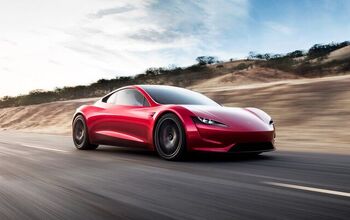Who Killed the Tesla Roadster?

The recent surge in the price of gas has turned this middle-aged man’s mind to thoughts of electric cars. And then I take a walk down the block and get cold feet. Down the street, there’s a driveway with four cars parked end-to-end. The three closest to the garage are electric car conversions, long-abandoned relics from the first two energy crises. The fourth car, closest to the street, is a Camry. Did the owner finally come to his senses? Or is he just waiting for his Tesla?
Over the past 120 years, the battery electric vehicle (EV) appeal has had its ups and downs. In the early decades of the twentieth century, wealthy owners quietly hummed to the opera in their Detroit Electrics automobile. Perched high above a bank of giant lead-acid cells below the floor, they could literally look down their noses (a pathological condition of EV ownership?) at the smoky, belching cars below.
The vehicles’ range was adequate for its time and purpose: 50 to 80 miles, at 20 mph or less.
Improvements in internal combustion engine (ICE) technology, better roads and the advent of cheap gas put the lead-acid EV into deep sleep. Energy crisis I and II gave the first jolt, nudging EV’s out of their technological torpor. Sort of.
In theory, the EV is a compelling package. Electric motors are compact, quiet, clean, reliable and powerful, generating maximum torque from 0 to 8000 rpm. Their efficiency beats ICE hands-down: 90+ percent vs. mid-30’s percent (under optimal conditions). And EV’s can convert de-acceleration back into electricity (regeneration), boosting their net efficiency.
The EV’s efficiency is greatest at low speed, exactly where the ICE engine is at its worst. (They make fabulous city cars and golf carts.) But air drag increases with the square of the speed. The faster you go, the faster the batteries drain their power.
All batteries’ energy storage density is profoundly less then gasoline; especially lead-acids. Ergo, their range is highly limited. The long-dead lead-acid conversions in my neighbor’s driveway (including a huge Cadillac) had a freeway range of twenty or thirty miles.
GM’s EV-1 pushed the lead acid envelope to its limits by using an ultra-slippery body with a Coefficient of Drag (CD) of 0.19. One hundred years of progress had yielded a tripling of cruising speed, but the EV’s range was still stuck at the Detroit Electric’s 60 to 80 miles. Given today’s operating conditions (highways and all), that’s not good enough for regular folks.
The ten years since the EV-1 have issued promising new battery chemistry, especially the lithium-ion cells powering our lap-tops and the much-ballyhooed Tesla Roadster.
The first time I read of the Tesla’s projected 250 mile range, I thought: “200 miles, if things go well.” That’s now the Roadster’s revised official range. Even if the Tesla only gets around 160 miles in normal use, that would still represent a doubling of range in ten years. From a historical perspective, that’s a giant step.
And despite its potential for scalding acceleration and high speed, the Tesla is still inherently highly efficient. The calculations for its 135 mpg “equivalent” claim are EPA-sanctioned, and roughly coincide with a steady speed of about 60mph and the range of 200 miles. So a 120 mph blast should yield about 34 “equivalent” mpg. Guilt-free speeding until busted?
Since the ICE runs most efficiently at wide-open throttle settings, performance cars pay a penalty at lower speeds. The Tesla’s jail-bait capability carries no intrinsic penalty, because the EV motor is almost equally efficient at any speed. But that “efficient” 120mph blast would run down the batteries in 50 miles or less. That alone would improve your odds of not getting busted.
Those range estimates are based on fresh batteries. The dirty little “secret” in Tesla’s closet: li-ion batteries start losing capacity from the get-go. After five years and 50k miles, battery capacity (range) is estimated to be down some 30 percent. Tesla owners can keep moving closer to work each year, or pony up.
Replacement battery pack price is unknown. Safety is unknown. At least one can live in hope that future batteries will be safer, more capable and maybe even cheaper.
Hard-core EV freaks and eco-poseurs are going to love the Tesla, despite the fact it doesn’t have room for a suitcase or a couple of bags of groceries. The Elise, on which the Tesla is based, wasn’t exactly designed for practicality (or 6’4” middle-aged guys like me). Never mind the $100k price.
With cheap hydro-power juice here in the North West, recharging an EV for a couple of bucks appeals. But how about something practical, along the lines of [the first gen] Scion Xb, with decent range, and priced reasonably. Now THAT would make a viable car, I think. And then I take another walk down the street…

More by Paul Niedermeyer
Latest Car Reviews
Read moreLatest Product Reviews
Read moreRecent Comments
- Redapple2 I love my geolander by yokohama. Wild Peak are almost as good.
- Redapple2 Why is a mexico BYD china car BAD -End of the World! But > gm < Buick Envision good (build more !) ?
- Kwik_Shift_Pro4X Supporting EVs is supporting Chi-nah.
- Eliyahu Oh, a nicer looking 2025 Camry!
- Analoggrotto Sell Canada to Mexico.

































Comments
Join the conversation
Miked's comments about energy density of gasoline vs. batteries are interesting but miss one very important part of the calculation: the engine. An electric engine weights about 1/10th that of a gas engine, which outweighs the gas 10:1 typically (not to mention transmission and pollution control that an electric car also does not need). So assuming you are content to keep the weight of both fuel and motor equal, you've got an extra factor of 10 to work with in measuring overall energy density...and suddenly, they're equal again! And your criticism goes away. (A Tesla devotes twice this weight to its batteries and is still very light, however.) On price, today batteries are expensive...and what happens when they wear out? Well: it seems to me they should be rented. Tesla's batteries (by my calculations) should cost about $25-30k. Amortized over their lifetime, they come to about twice the US price of gasoline per mile (the electricity itself is negligible by comparison). But gas in Europe is twice as expensive...thus, replacing your gas-powered car with an electric should leave you with almost exactly the same overall price per mile or per year total, even counting periodic battery replacements. If batteries are rented instead of purchased (and thus replaced "for free" when necessary), the up-front and per-week costs also start to closely resemble gas engines. Add in the $4000/year congestion charge in London that you don't have to pay for an electric, and it can be a big savings...even counting those pricey batteries.
Electric vehicles with good performance exist today. The list includes Tesla Roadster sport car, Electrovaya Maya-100 compact SUV and APX. There are probably more others. They have a range of more than 200 miles. The last two can be recharged in less than 10 minutes. The only drawback is the car price, which is high mainly due to battery cost. Battery firms allocate much R&D to lower these cost so a replacement after 5 years should not be that expensive. Charging in the street can be done with easy instalation with meters. The payment can be automatic by credit cards like in gas stations. Fast recharge requires special installation but it is needed mainly on the highways